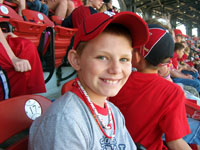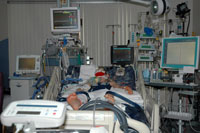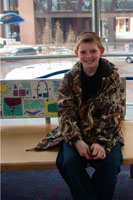 Just after noon on January 30, 2010, Sherry Mitchem picked up the phone.
Just after noon on January 30, 2010, Sherry Mitchem picked up the phone.
“They said Drew had an accident.” She remembers. “I thought, ‘Oh, he hurt his arm or leg.’ I never imagined it was going to be such a traumatic event.”
Eleven-year-old Drew and a friend were riding a sled pulled by an ATV. The ATV turned a corner, the sled flipped, and both boys flew off. Drew went one direction, his friend, another.
“Drew was just a couple inches the wrong way,” his mom says.
While his friend was able to get right back up, Drew hit the bumper of a parked truck head-on.
“By the time we got there, the ambulance had already arrived.”
Drew’s mom rode with him to the local hospital, where a CT scan revealed a fracture in his skull. A medical team loaded him onto a helicopter, and by 4:30 that afternoon he arrived at St. Louis Children’s Hospital. There, a neurocritical care team that includes four pediatric neurosurgeons, three critical care physicians and several neurologists would evaluate his condition and monitor him for weeks to come.
“We saw so many people. I just got to the point where I started collecting everyone’s cards,” Sherry says.
Among the cards in Sherry Mitchem’s collection was one belonging to Barb Miller, clinical care coordinator for the Pediatric Neurocritical Care Program (PNCP).
“You have all of these people focusing on one child. Parents are overwhelmed, and you need some continuity for them,” Miller says. “I’m there in the background all the time.”
For the Mitchems, she was in the foreground, as well.
“We aren’t aware of other programs that provide this role of facilitator for children with brain injury,” says Dr. Jose Pineda, MD, director of the PNCP and one of Drew’s doctors. “As the PNCP coordinator, Barbara joins bedside rounds with the team and coordinates decision making between the PNCP, the Trauma Service, Neurosurgery, Radiology, Neurology and the Rehabilitation Service. She also facilitates streamlined, safe brain MRI studies. Multidisciplinary care is complex, and communication can be a challenge: Barbara bridges input from all specialties, making sure children with brain injury have access to the best care possible. Importantly, she also communicates with EMS providers and the Emergency Department, providing them with updates on how the wonderful care they provide helps our patients.”
Her experience is typical of a parent whose child has suffered a brain injury. Over 20 staff members often join forces to care for a single child.
“Doctors and interns and nurses – you had neuro and surgical neuro, then doctors and nurses for the PICU,” Sherry recalls.
Miller made sure everyone was on the same page.
“To me, communication is key,” she says. “Because our communication is better, our therapies advance more effectively.”
In Drew’s case, communication across multiple services would prove critical. Immediate assessments confirmed he would need to have a bolt surgically placed so that the team could monitor the pressure building inside his skull.
“Together with the ICU, ED and trauma programs, we establish pathways that make sense,” says Jeffrey Leonard, MD, neurosurgeon and co-director of the PNCP. “We’ve shown over the last several years how this approach has directly reduced mortality, and in my opinion, improved outcomes as well.”
The Mitchems could only hope for a positive outcome as they sat in their son’s intensive care room day after day. He remained in a drug-induced coma, but even with that the pressure and swelling in his head exceeded critical limits. Doctors had to surgically insert a drain.
 “He had so many machines, there wasn’t room for people,” his mom remembers of his room.
“He had so many machines, there wasn’t room for people,” his mom remembers of his room.
It took another week, but eventually, his levels grew more consistent and doctors began to gradually decrease dosages and disconnect machines.
“He started waking up on day 14,” Sherry says.
And the next day, Drew surprised everyone.
“He started walking in the PICU on day 15,” his mom says, laughing. “The nurses were amazed. They said no one walks in the PICU!”
“We begin the neurorehabilitation process in the ICU,” says Dr. Michael Noetzel, co-director of the neurocritical care program and neurologist-in-chief at St. Louis Children’s Hospital. “When we have compared ourselves nationally, we have kids that are making a better recovery in the time that they’re on our service because of many reasons, including the fact that we’re able to get to them earlier, before the onset of more difficult-to-treat problems.”
Drew followed that path. He began his rehabilitation in the ICU, then moved to a neurorehabilitation floor a couple days later.
There, he saw another team of doctors and therapists, but not all of the faces were new.
“We would still see Barb,” Sherry says. The neurocritical care clinical coordinator followed Drew throughout the 32 days he spent in the hospital, which was reassuring to his parents.
“It made us feel better that they all knew what the other one was doing.”
 That kind of continuity helped Drew make an exceptional recovery. A year after the sledding accident, he’s playing basketball and baseball.
That kind of continuity helped Drew make an exceptional recovery. A year after the sledding accident, he’s playing basketball and baseball.
“It was hard to see there was an end in sight,” his mom says, looking back. “Now, to see how far he’s come, I’m really amazed. I truly think the reason is the care he got.”
And while his parents remember every minute of his 32 day stay at the hospital, Drew doesn’t recall quite as much. The family recently returned to visit the doctors and nurses who helped him heal. While he had memories of being in the hospital, he didn’t remember the trauma.
“The kids never remember,” Miller says with a smile. “That means we’ve done our job.”










